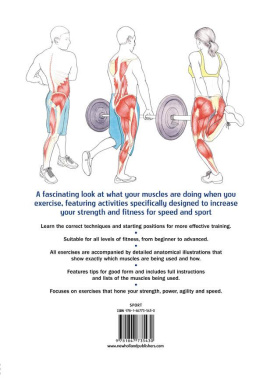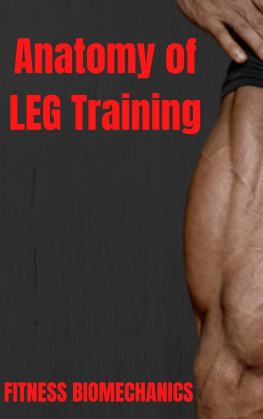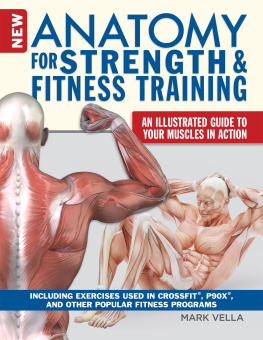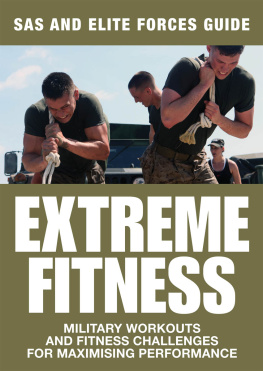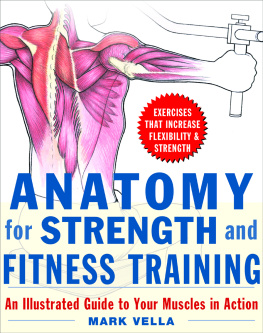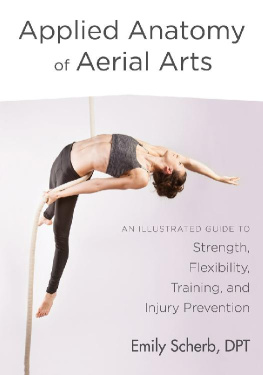Claudia Friedlander - Complete Vocal Fitness: A Singer’s Guide to Physical Training, Anatomy, and Biomechanics
Here you can read online Claudia Friedlander - Complete Vocal Fitness: A Singer’s Guide to Physical Training, Anatomy, and Biomechanics full text of the book (entire story) in english for free. Download pdf and epub, get meaning, cover and reviews about this ebook. publisher: Rowman & Littlefield;, genre: Romance novel. Description of the work, (preface) as well as reviews are available. Best literature library LitArk.com created for fans of good reading and offers a wide selection of genres:
Romance novel
Science fiction
Adventure
Detective
Science
History
Home and family
Prose
Art
Politics
Computer
Non-fiction
Religion
Business
Children
Humor
Choose a favorite category and find really read worthwhile books. Enjoy immersion in the world of imagination, feel the emotions of the characters or learn something new for yourself, make an fascinating discovery.

- Book:Complete Vocal Fitness: A Singer’s Guide to Physical Training, Anatomy, and Biomechanics
- Author:
- Publisher:Rowman & Littlefield;
- Genre:
- Rating:4 / 5
- Favourites:Add to favourites
- Your mark:
- 80
- 1
- 2
- 3
- 4
- 5
Complete Vocal Fitness: A Singer’s Guide to Physical Training, Anatomy, and Biomechanics: summary, description and annotation
We offer to read an annotation, description, summary or preface (depends on what the author of the book "Complete Vocal Fitness: A Singer’s Guide to Physical Training, Anatomy, and Biomechanics" wrote himself). If you haven't found the necessary information about the book — write in the comments, we will try to find it.
Complete Vocal Fitness: A Singer’s Guide to Physical Training, Anatomy, and Biomechanics — read online for free the complete book (whole text) full work
Below is the text of the book, divided by pages. System saving the place of the last page read, allows you to conveniently read the book "Complete Vocal Fitness: A Singer’s Guide to Physical Training, Anatomy, and Biomechanics" online for free, without having to search again every time where you left off. Put a bookmark, and you can go to the page where you finished reading at any time.
Font size:
Interval:
Bookmark:
Artist and occupational therapist Sandy Escobars diverse projects include anatomical illustration, community art, mental health support, and health-care research. She has been creating art for ten years and has previously illustrated vocal anatomy for publications and web content for the Vibrant Voice Technique. Sandy is passionate about creating accessible, inclusive spaces in health care, communities, and peoples homes. Her broad-ranging activities include producing collaborative murals, holding workshops to design accessible spaces for people with mental illnesses, and recommending orthopaedic equipment to clients. She earned a BFA in interdisciplinary visual art from the Nova Scotia College of Art and Design, and MS in occupational therapy from Dalhousie University.
Photographer Daniel Welch combines his artistic, technical, acting, and musical training to create dynamic images for books, magazines, billboards, and album covers. While Daniels subjects include performers of all types, his work reflects his enduring passion for classical singing. He is artistic director of Reclamation Opera, a company that produces film versions of operatic masterpieces designed to delight new audiences and offer fresh perspectives to die-hard fans.
Soprano Kirsten Chambers has performed with the Metropolitan Opera, Florida Grand Opera, and New York City Opera and has appeared in concert with the American Symphony Orchestra and The Orchestra Now. Her signature roles are among the most physically demanding in the repertoire and include the title role in Salome and Elsa in Lohengrin. While fitness had been an important part of Kirstens life growing up, exercise eventually took a backseat to her musical studies. She soon got a wake-up call: One day I was in a staging rehearsal that required my character to run up and down stairs and then sing long declaratory phrases.... I kept running out of breath! She took up a regimen that includes cardio and strength training and now has stamina to burn. Kirsten finds that fitness supports her singing in many ways: I move more naturally on stage; my voice warms up faster and more efficiently; mentally, Im more focused; and the improvements to my posture have stabilized my breath.
Baritone David Adam Moore has performed with major opera companies worldwide, including the Metropolitan Opera, Teatro alla Scala, Covent Garden, Lyric Opera of Chicago, and the Salzburg Festival. A celebrated interpreter of contemporary music, he has created roles for some of todays most important living composers, including Thomas Ads, Peter Etvs, and David T. Little. He is also known for his work as a stage director, composer, and video designer, frequently collaborating on multimedia productions of both classic and new works. While on the road, David enjoys parkour as a means of both challenging himself physically and becoming acquainted with new cities. He experiences his artistry and physicality as deeply integrated but emphasizes the primacy of vocal excellence for opera performance: A full, beautiful voice and an engaging character will always give audiences more goose bumps than well-defined abs.
Claudia Friedlander, DMUS, NASM-CPT, CES, PES, is a voice teacher and fitness expert based in New York City. Born in Queens and raised in New Jersey, she began her musical studies as a clarinetist. Her passion was fueled by her early experiences playing in the Young Artists Orchestra at Tanglewood under the batons of Seiji Ozawa and Leonard Bernstein. This led to private studies with Richard Stoltzman, a masters degree in clarinet from Peabody Conservatory, and a brief stint as the principal clarinetist of Orquesta Sinfnica del Estado de Mxico.
Shortly after completing her undergraduate studies at Bennington College, she was encouraged to study singing by conductor Blanche Honegger Moyse. She sang while continuing to play her instrument, earning a masters degree in voice at Peabody. Eventually, her fascination with the physiological process of singing eclipsed her passion for clarinet. In 1995, she began doctoral studies in vocal performance and pedagogy at McGill University, which she completed in 1999.
In 2002, Dr. Friedlander moved to New York City, apprenticed herself to renowned pedagogue W. Stephen Smith, and established her voice studio. In her first few years of teaching, frustration with her inability to methodically and rigorously address the mechanical dysfunctions of some of her students motivated her to study kinesiology. After receiving her certification as a personal trainer from the National Academy of Sports Medicine, she became inspired to apply the concept of sports-specific training to professional voice training.
Dr. Friedlander has presented workshops on vocal fitness for the Voice Foundation and the Performing Arts Medicine Association and was an invited panel discussant on health and wellness for Opera America. Her students have performed on Broadway and at leading opera houses including the Santa Fe Opera and the Metropolitan Opera. She is the author of the monthly column Musings on Mechanics for Classical Singer magazine, as well as writing a widely read and cited blog on vocal technique and fitness, The Liberated Voice. In 2008 she joined the faculty of the Weill Music Institute at Carnegie Hall, where her most recent project was the development, in collaboration with Joyce DiDonato, of The Singers Audition Handbook, an interactive online career development guide for young singers.
Minimal equipment is required to perform the exercises in chapter 6, and you can pack lightweight portable versions when traveling. Here is a list of essentials.
Exercise mat. Hard floors and carpets can be slippery or uneven. Use a mat when exercising away from the gym for both prone and upright movements. Take a slim, lightweight mat (under 2 pounds) with you on the road.
Resistance bands with handles and door anchors. Rubber resistance bands provide a wide range of tension and challenge and can substitute for both cable machines and dumbbells. Pack a pair in light- and medium-weight resistance when traveling.
Dumbbells. The exercises in chapter 6 are designed to be performed with light- to medium-weight dumbbells, so a small selection ranging from 3 pounds to 12 pounds is all you need at home. Travel dumbbells are available that weigh less than 2 pounds per pair and can be filled with water to weigh up to 16 pounds each.
Foam roller. Foam rollers are available in varying degrees of firmness, so choose one that meets your comfort level. Collapsible versions are available for travel.
Personal massager. A large, durable massager is helpful, not only for addressing post-exercise tension but also for alleviating the muscular kinks that accumulate from long flights or sleeping in unfamiliar beds.
Stable exercise shoes. Cross trainers are best for strength training exercises. Choose a shoe that provides your feet and legs with solid support. The stabilization exercises in chapter 6 will be safer and more effective when you are not also required to compensate for unstable footwear.
Bozeman, Kenneth. Practical Vocal Acoustics: Pedagogic Applications for Teachers and Singers. Hillsdale, NY: Pendragon Press, 2014.
Kenneth Bozemans book makes vocal acoustics accessible and easily applicable in the studio. This is a concise, practical guide for understanding and improving the way singers define vowels, amplify vocal production, and vary timbre.
Calais-Germain, Blandine. Anatomy of Movement. Seattle: Eastland Press, 1993.
Font size:
Interval:
Bookmark:
Similar books «Complete Vocal Fitness: A Singer’s Guide to Physical Training, Anatomy, and Biomechanics»
Look at similar books to Complete Vocal Fitness: A Singer’s Guide to Physical Training, Anatomy, and Biomechanics. We have selected literature similar in name and meaning in the hope of providing readers with more options to find new, interesting, not yet read works.
Discussion, reviews of the book Complete Vocal Fitness: A Singer’s Guide to Physical Training, Anatomy, and Biomechanics and just readers' own opinions. Leave your comments, write what you think about the work, its meaning or the main characters. Specify what exactly you liked and what you didn't like, and why you think so.

